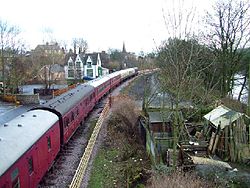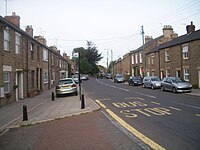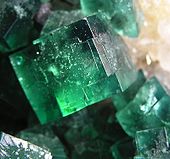Frosterley: Difference between revisions
Created page with "{{Infobox town |name=Frosterley |county=County Durham |picture=Frosterley Station and Xmas Special - geograph.org.uk - 75434.jpg |picture caption=The Weardale Railway in Frost..." |
m clean up, typos fixed: a 19th century → a 19th-century |
||
| (One intermediate revision by one other user not shown) | |||
| Line 19: | Line 19: | ||
==Name== | ==Name== | ||
The earliest reference to | The earliest reference to the village by name occurs in the Close Rolls of 1239, where it appears as ''Frosterlegh''. It appears to mean a clearing in the forest. | ||
==History== | ==History== | ||
| Line 35: | Line 35: | ||
==Rogerley Mine== | ==Rogerley Mine== | ||
The Rogerley mine, located in a 19th century limestone quarry, is the only mine known to be operated on a commercial basis solely for mineral specimens in the UK. | The Rogerley mine, located in a 19th-century limestone quarry, is the only mine known to be operated on a commercial basis solely for mineral specimens in the UK. | ||
==Spot and leisure== | ==Spot and leisure== | ||
Latest revision as of 15:26, 27 January 2016
| Frosterley | |
| County Durham | |
|---|---|
 The Weardale Railway in Frosterley | |
| Location | |
| Grid reference: | NZ025375 |
| Location: | 54°43’40"N, 1°57’32"W |
| Data | |
| Post town: | Bishop Auckland |
| Postcode: | DL13 |
| Dialling code: | 01388 |
| Local Government | |
| Council: | County Durham |
| Parliamentary constituency: |
North West Durham |
Frosterley is a village in County Durham. It is to be found in Weardale, beside the River Wear close to its confluence with Bollihope Burn; between Wolsingham and Stanhope, 18 miles west of the City of Durham.
Frosterley is on the Weardale Railway. Heritage trains currently run to Stanhope and Wolsingham
Name
The earliest reference to the village by name occurs in the Close Rolls of 1239, where it appears as Frosterlegh. It appears to mean a clearing in the forest.
History

The area has been inhabited since Mesolithic times: Mesolithic flints and Neolithic stones axes have been found in the vicinity. A bronze spearhead was found in a local quarry dating to the late Bronze Age circa 1000 BC. The village itself has mediæval origins and although the original houses have long been replaced the village still retains its mediæval pattern.
On the north of the village are the remains of St Botolph’s Chapel. What remains is an earthwork mound surrounded by a modern housing estate (Kirk Rise). The site was excavated in 1995, before the estate was built, and the probable remains of an ecclesiastical building was discovered. It is thought this was built around the 10th or 11th century and dedicated to the East Anglian saint, St Botolph, who lived in the 7th century and was very popular in the Middle Ages. It is thought the village originally may have been named after the saint.

Frosterley Marble

A black limestone containing fossil corals of the Carboniferous Period, some 325 million years ago. When cut and polished the result is a beautiful ornate stone, much desired for church decoration, particularly during the Middle Ages
Frosterley Marble has been taken from the Rogerley Quarry for more than 700 years; the decorative columns found in Durham Cathedral date from about 1350. Examples of Frosterley Marble can be found at several places in the village, the church of St Michael and All Saints, the railway station and behind the car park in the centre of the village.
Rogerley Mine
The Rogerley mine, located in a 19th-century limestone quarry, is the only mine known to be operated on a commercial basis solely for mineral specimens in the UK.
Spot and leisure
There is a King George V Playing Field in the village.
Outside links
| ("Wikimedia Commons" has material about Frosterley) |
- St Botolph
- Weardale Railway
- Stone in Archaeology database
- Frosterley Marble leaflet (North Pennines Rockworks project)
- Rogerley Mine information and photo galleries at Mindat.org
- Frosterley Marble
